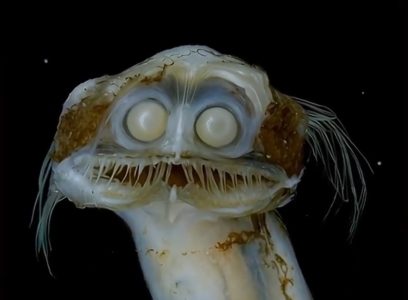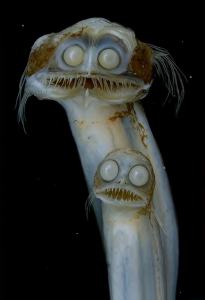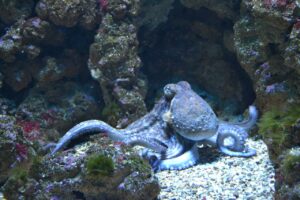 Pin
Pin Telescope Fish (Gigantura indica) / Image by Seafaring Souls
Nearly a mile beneath the ocean’s surface, where sunlight has never touched, a shimmery, eel-like creature glides through complete darkness with eyes that look like tiny telescopes. This isn’t science fiction—it’s the incredible world of Gigantura indica, better known as the Telescope Fish.
This remarkable deep-sea predator calls the twilight zone home, that mysterious layer of ocean between 500 and 2000 meters deep where most life on Earth has never ventured. Here, in waters so dark that your eyes would be completely useless, the Telescope Fish has evolved into something that seems almost alien.
What makes this creature so fascinating isn’t just its bizarre appearance, but how perfectly it’s adapted to survive in one of our planet’s most extreme environments. Every feature of its body tells a story of millions of years spent perfecting the art of deep-sea hunting, where a single missed meal could mean the difference between life and death.
Table of Contents
A Fish Built Like No Other
 Pin
Pin Telescope Fish (Gigantura indica) / Image by Seafaring Souls
The first thing you’d notice about a Telescope Fish isn’t its long, ribbon-like tail or its shimmering body—it’s those incredible eyes. These aren’t your typical fish eyes. They’re tubular, almost cylindrical, and they point straight up toward the faint traces of light filtering down from above. Think of them as biological periscopes, designed to catch the tiniest glimmer in an otherwise pitch-black world.
But here’s where it gets really interesting: those eyes contain some of the largest lenses found in any fish relative to body size. These massive lenses work like the objective lenses in a powerful telescope, gathering every available photon of light. While we need flashlights to see anything in dim conditions, the Telescope Fish can spot the faint silhouette of prey against the barely-there glow of surface light filtering down through thousands of feet of water.
The Mystery of Silver Skin Without Scales
Most fish are covered in overlapping scales that protect them like tiny shields, but the Telescope Fish took a completely different approach. Instead of scales, its entire body is coated with a substance called guanine—the same reflective material that makes fish scales shimmer, but applied like a smooth, mirror-like paint job.
This silvery coating does something remarkable in the deep ocean. When bioluminescent creatures flash their natural lights nearby, the Telescope Fish’s body reflects that light in scattered directions, making it nearly invisible to both predators and prey. It’s like wearing a cloak made of mirrors in a world where most communication happens through flashes of living light. The guanine coating is so effective that the fish can practically disappear against the dark water, becoming nothing more than a faint glimmer that could easily be mistaken for floating debris.
That Incredible Expanding Jaw
Here’s something that sounds impossible until you see it happen: the Telescope Fish can swallow prey that’s actually larger than its own body. This isn’t just a party trick—it’s a crucial survival skill in the deep ocean where meals are few and far between. When you live in a place where you might not encounter food for weeks, you need to be able to take advantage of every opportunity, no matter how big it is.
The secret lies in the fish’s incredibly flexible jaw and expandable throat. Think of it like a snake’s ability to unhinge its jaw, but taken to an even more extreme level. The bones in the Telescope Fish’s skull can separate and stretch, while its throat can balloon outward to accommodate prey that would seem impossible to fit. This remarkable adaptation means that a fish the length of a ruler can successfully hunt and consume prey that might be twice its normal body width, storing enough energy to survive long periods without another meal.
Life in the Ocean's Twilight Zone
The world where the Telescope Fish lives is unlike anywhere else on Earth. At depths between 500 and 2000 meters, the water pressure is crushing—literally hundreds of times stronger than what we experience at sea level. The temperature hovers just above freezing, and the darkness is so complete that it makes a moonless night seem bright by comparison. Yet this harsh environment is home to some of the most incredible creatures on our planet.
This zone, called the bathypelagic or twilight zone by scientists, represents the largest living space on Earth, yet we know less about it than we do about the surface of Mars. Food doesn’t grow here like it does in sunny surface waters, so every creature must either hunt, scavenge, or make the dangerous journey upward each night to feed. The Telescope Fish has chosen to stay put and become an ambush predator, using its specialized vision to spot prey moving against the faint glow filtering down through thousands of feet of water above.
The Science Behind Those Remarkable Eyes
Understanding how the Telescope Fish’s eyes work requires thinking about light in a completely different way than we’re used to. At the surface, we have so much light that our biggest challenge is often filtering out the excess—that’s why we wear sunglasses. But imagine trying to read a book using only the light from a single match held a mile away. That’s essentially what the Telescope Fish’s eyes are designed to do.
The tubular shape of these eyes serves a specific purpose that becomes clear when you understand the physics involved. By pointing straight up, the eyes are positioned to catch the maximum amount of downwelling light—the faint traces of sunlight that manage to penetrate the ocean’s depths. The large lenses then concentrate this minimal light onto highly sensitive retinas packed with specialized cells called rods. These rods are so sensitive that they can detect individual photons of light, making the Telescope Fish’s vision system one of the most efficient biological light-gathering devices known to science.
A Rare Glimpse Into Hidden Lives
In 2001, researchers aboard the Monterey Bay Aquarium Research Institute’s vessel were operating their remotely operated vehicle (ROV) Tiburon when they encountered something extraordinary at 1,214 meters depth near the Hawaiian Islands. There, suspended in the eternal darkness, was a pair of Telescope Fish—the first time anyone had ever documented these mysterious creatures alive in their natural habitat.
What the researchers witnessed was both beautiful and haunting. The two fish moved with an almost ghostly grace, their silvery bodies catching and reflecting the ROV’s lights like living mirrors. The footage revealed behaviors that scientists had only theorized about, showing how these remarkable predators actually navigate and hunt in the crushing darkness of the deep ocean. This single encounter provided more insight into Telescope Fish behavior than decades of studying preserved specimens could offer, demonstrating just how much we still have to learn about life in Earth’s deepest waters.
 Pin
Pin The Meaning Behind the Name
The scientific name Gigantura reveals what early researchers noticed first when they examined these unusual fish. The name combines two Latin words: “gigant,” meaning giant, and “ura,” referring to the tail. At first glance, this might seem puzzling since the Telescope Fish isn’t particularly large compared to many ocean predators. But when you see one in person, the name makes perfect sense.
The “giant” part doesn’t refer to the fish’s overall size, but rather to its most striking feature—that incredibly long, ribbon-like tail that can stretch far beyond what you’d expect for such a compact body. This tail isn’t just for show either. In the deep ocean where every movement costs precious energy, that elongated tail provides efficient propulsion with minimal effort. The fish can glide through the water with subtle undulations, moving like a living ribbon through the darkness while barely disturbing the surrounding water that might alert potential prey to its presence.
How They Hunt in Total Darkness
Hunting in the deep ocean requires strategies that would seem impossible in our sunlit world above. The Telescope Fish has perfected a technique called “silhouette hunting,” where it positions itself below potential prey and looks upward toward the faint glow of surface light filtering down through miles of water. Any creature swimming above appears as a dark shadow against this barely perceptible backdrop, making them visible to the Telescope Fish’s incredibly sensitive eyes.
This hunting method requires remarkable patience and precision. The fish must remain nearly motionless, suspended in the water column like a living trap, waiting for the perfect moment when prey drifts within striking distance. When that moment comes, the attack happens with lightning speed. The Telescope Fish’s flexible jaw springs into action, expanding to engulf prey that might seem impossibly large for such a relatively small predator. This ambush technique is so energy-efficient that the fish can afford to wait for hours or even days between meals, conserving every bit of energy for the crucial moment when opportunity presents itself.
Surviving the Pressure Cooker
Living at depths where the water pressure reaches crushing levels requires some serious biological engineering. At 1,000 meters down, the pressure is about 100 times stronger than what we experience at sea level—equivalent to having a small car sitting on every square inch of your body. For the Telescope Fish, this extreme pressure is just another day at the office, but achieving this feat required millions of years of evolutionary fine-tuning.
The key lies in how these fish manage the gases and fluids inside their bodies. Unlike surface fish that have gas-filled swim bladders to control their buoyancy, deep-sea creatures like the Telescope Fish have evolved different solutions. Their bodies are filled with specialized fats and oils that don’t compress under pressure, allowing them to maintain their shape and function even when the surrounding water would instantly crush most surface-dwelling creatures. Think of it like the difference between trying to squeeze a balloon versus trying to squeeze a water bottle—the Telescope Fish has essentially become more like the water bottle, with incompressible materials that can withstand the ocean’s immense pressure.
Why We Know So Little About Them
The Telescope Fish remains one of the ocean’s greatest mysteries, and there are practical reasons why our knowledge stays limited. Getting to their deep-water home requires expensive research vessels, sophisticated submersibles, and technology that can withstand crushing pressures. Even when scientists do reach these depths, the chances of encountering a Telescope Fish are incredibly slim—they’re scattered across vast expanses of open ocean, and their populations appear to be naturally low.
Most of what we’ve learned about these creatures comes not from direct observation, but from specimens accidentally caught in deep-sea fishing nets or scientific trawls. These encounters are so rare that each specimen becomes precious to researchers, who must piece together the puzzle of Telescope Fish biology using limited physical evidence. The 2001 MBARI footage remains one of the most significant breakthroughs in understanding these fish, precisely because it showed us behaviors we could never learn from preserved specimens. Every new observation adds another small piece to our understanding, but the complete picture of how Telescope Fish live, reproduce, and interact with their environment remains largely hidden in the ocean’s depths.
What These Fish Teach Us About Life's Limits
The existence of the Telescope Fish challenges everything we thought we knew about the boundaries of life on Earth. These remarkable creatures demonstrate that evolution can produce solutions to problems that seem impossible to solve, creating living beings that thrive in conditions that would instantly kill most other forms of life. Their success in the deep ocean’s extreme environment offers valuable insights that extend far beyond marine biology.
Understanding how Telescope Fish have adapted to their harsh world helps scientists think differently about where life might exist elsewhere in the universe. If creatures can evolve to see in near-total darkness, withstand crushing pressures, and survive on scarce food resources in Earth’s deep oceans, it opens up possibilities for life in equally extreme environments on other planets. The Telescope Fish serves as a living example of life’s incredible adaptability, showing us that the boundaries of what’s possible are much wider than we might have imagined. Each discovery about these mysterious deep-sea hunters adds to our growing appreciation of how creative and resilient life can be when faced with seemingly impossible challenges.
FAQs
Most Telescope Fish reach about 6 inches in length, but their ribbon-like tails can make them appear much longer than their compact bodies suggest.
No, the extreme pressure difference would be fatal. Their bodies are specially adapted for deep-water conditions and cannot survive in shallow water.
Unlike many deep-sea fish, Telescope Fish don’t produce their own light. Instead, they rely on their reflective silver coating and incredible eyesight.
Extremely rarely! The 2001 footage remains one of the few times these fish have been observed alive in their natural habitat.
Their tubular shape and oversized lenses can gather and focus tiny amounts of light that would be invisible to normal eyes, like biological telescopes.



































What a cutie😘